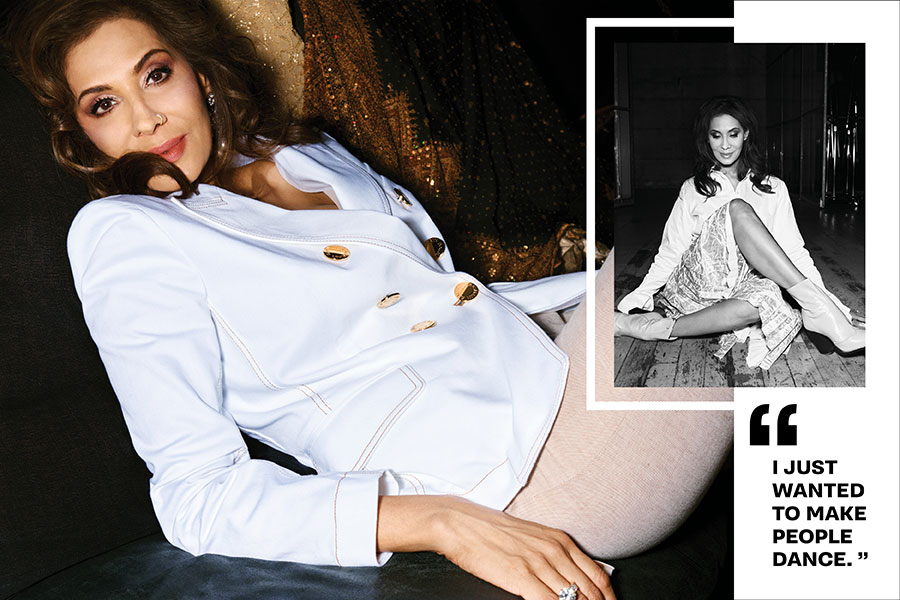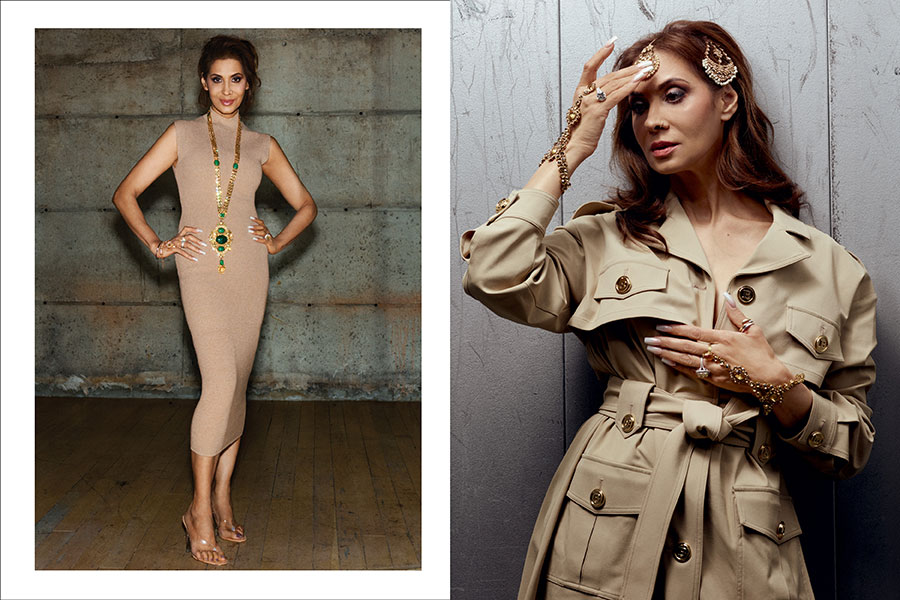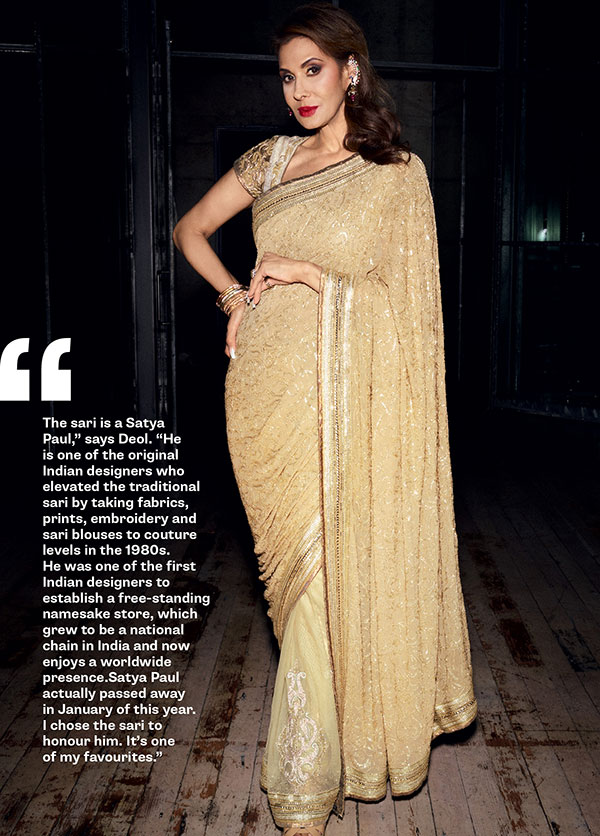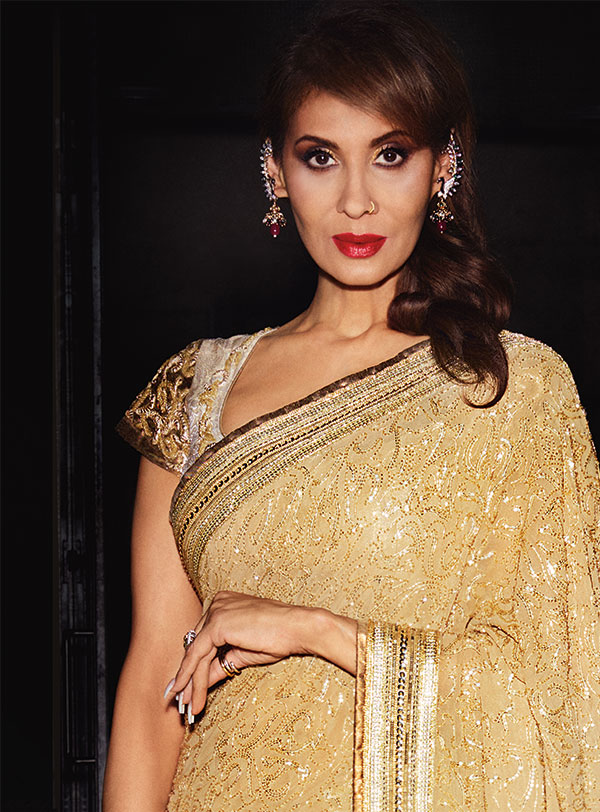Still Electric: Monika Deol On the Impact of Electric Circus and Blazing a Trail For South Asians in Canadian Entertainment

After leaving the MuchMusic spotlight more than 20 years ago, former Electric Circus host and current beauty entrepreneur Monika Deol chats with Zoomer about the impact of the show, her emergence in the entertainment world and how she inspired others by embracing her South Asian culture. Photo: Bryan Adams
“I just want to make people dance.”
That was Monika Deol this spring, revisiting ghosts of boogies past. A club kid through and through, the South Asian girl who grew up on a dairy farm was spinning as a part-time DJ in a Winnipeg club while attending university in the early ’80s. Playing up to three sets a night, she would do school work in-between. She was playing a lot of Madonna. A lot of the Bangles and New Order.
“My take on music has always been every genre is good — and all music matters — as long as it is a well-written song,” says Deol, 56, laying down her dance-floor MO. When she fronted her own bar band, dubbed Perfect Kiss, which played towns like Thompson, Man., she’d put together song lists where she would throw on Madonna, followed by Led Zeppelin. “You can’t! You can’t!” others would counter. “Yes, you can,” she would volley back.
That can-do ’tude carried her along nicely, of course, when she morphed into one of the most recognizable faces in Canada. A knockout who gave viewers a fabulous red lip and even better delivery in a voice full of husky secrets, she was a brew of both glamour and gravitas on the uniquely Canadian phenomenon that was Electric Circus. It was TikTok before TikTok was TikTok and live streaming before live streaming was live streaming. In fact, MuchMusic, which broadcast Electric Circus across the nation for 10 years, is being revived on TikTok, where it promises live performances and artist-hosted events.
“How to explain the impact of MuchMusic …” Deol posted on Instagram in June along with a picture of Drake wearing an Electric Circus T-shirt, adding a thinking-face emoji and the acronym, “iykyk,” which means “if you know, you know.” The weekly, real-time dance party that began on Citytv in 1988 unleashes a gush of nostalgia for a certain generation, with memories of a show that was less a show and more a rabbit hole to Canada’s hottest club — but on TV. It was a wonderland for people from all walks of life, beamed into living rooms so everyone could vicariously dance along.

Deol was at the white-hot centre of all that. She was not just the slinky figurehead around whom this storm swirled, but also someone who was as synonymous with Toronto as a certain looming tower in the nation’s biggest metropolis. She was also one of the stalwarts of a Queen Street West scene that seems but a crumpled memory.
But that was then, and she is now staring at me via the mists of Zoom from her base in Vancouver. The years have only added to her allure and there’s a depth to the earthy brunette’s beauty. She is here to talk about the Electric Circus reboot she is emceeing, a series of five live events scheduled for September. And yet, I want to take the opportunity to drill down on the making of Monika and why, at the height of her career, she walked away from it all.
About that farm she was raised on outside Winnipeg? Yes, it is true: She milked a cow or two (or 100) in her day. No, it is not accurate to say it was entirely idyllic.
“My father was a turban-wearing Sikh all of his life. My mom wore a bindi [a coloured dot on the forehead] every day of her life … and wore saris. They were very visibly different. But they were very proud of who they were,” she says of her parents, both teachers, who emigrated to Canada from Punjab, India, when she was a young girl. “And the upside of that is that it made me confident in being different. It did not bother me. The downside is that we did get stereotyped a lot. Growing up in small towns, everybody is German, Polish, Ukrainian … and there was us.”

Deol has lived with a lot of duality, something she says a lot of immigrants can relate to. “I was someone who was raised in a very strict, misogynistic kind of culture, with expectations put on me from the family — a culture that tells you ‘we believe in you, we champion you’ as long as it is a doctor, lawyer, teacher, accountant, engineer. The big five, as I like to call it. The other part of me was someone who, from when I was very, very little, was very into music. Someone who wanted to be in entertainment. I wanted this artistic life, but I was always trying to reconcile one half with the other half.”
That prompts memories of writing random jingles for products she liked and making up songs for kicks. It has been on her mind because, during the pandemic last year, she finally had the time to start clearing out some boxes and found old notebooks full of her scribblings.
Going down the well of the past can be a precarious thing, because Deol has been thinking about more painful times, too. “I grew up in a family where there was a fair bit of domestic violence, and a fair bit of substance abuse …” she says, trailing off. It is not a disclosure she has made before in an interview. “I don’t want to get into it too much, because it is not my story to tell,“ she eventually adds, but a little later refers to “violence against my mother.”
At the time, she and her two sisters were very close. “We only had each other. It was a matter of survival.” But when Deol walked out the door at 17, “I started to live life my way — with music.” Although, notably, she did stay in school then, studying towards a Bachelor of Arts at the University of Winnipeg.
“You were still the Good Girl,“ I point out.
“I was always the Good Girl,” she vouches.

She readily admits she “compartmentalized” a lot of this at the time, but confirms that working as a DJ “created a lot of animosity and chaos in my family. My parents were not happy.” That, plus the fact she was not living at home, which was atypical for a young woman of her ilk back then.
Her father died not long after that whole time, something that still brings up a host of emotions. “In all honesty, when my dad died — in an odd way — it freed me.”
Enter Deol, the emergent TV star. It’s the backstory of the singer-songwriter who took the bus from Winnipeg to Toronto to “shop her demos,” making a pilgrimage to all the labels. “I needed to get a record deal,“ she says. Not much was happening on that front, but the higher-ups at MuchMusic got wind of her. When she met John Martin, the erstwhile head of the channel, at a function, he told her “they were looking for on-air talent, but they wanted someone who lived the life,” not just another journalism-school grad.
It was baptism by fire as she took a job in entertainment news. “I can teach you how to make good television, but I can’t teach you how to be passionate,” she recalls Moses Znaimer, the co-founder and creative mind behind Citytv, CP24 and MuchMusic, saying at the time. “You either have it or you don’t.” She learned news lingo on the fly, a major feat considering Deol had grown up with a stutter and was deathly afraid of public speaking. During her DJ days, “they even had to push me to do the ‘10-9-8’ [countdown] on New Year’s Eve!” she shares.
Months into her job at Citytv, Znaimer, who is also the founder and CEO of ZoomerMedia, floated the idea of a new dance show. People dancing? Live? Deol was in. “We were making it up as we went along,“ she beams. She started off as a junior co-host, and the show initially took off as a Saturday afternoon thing (which was, admittedly, a little odd). It did not get much play, or budget, initially. But it grew. And grew. It went from the local Citytv channel to a national, nighttime slot on MuchMusic in 1993, as it attracted scores of curiosity seekers and visiting celebs.
It was like one of those Benetton ads of yesteryear come to life: People of all colours, sexual persuasions and walks of life, dying to be in the mix, whether to shimmy inside or just gawk from the windows on Queen Street West. In fact, as a manifestation of Znaimer’s “living movie” ethos, the line between inside and outside was blurred on Electric Circus. People dressed the way they wanted and moved in their own way to a medley of pop hits, rock anthems and hip hop. Deol makes the point that it was not a place just for professional dancers, or the best dressed, or even the super good-looking — it was, ultimately, about a certain energy. A live-ness.
It also happened to be a petri dish for emerging talent. Maestro Fresh Wes once performed on the show in a career-making appearance, while [now] world-renowned comic Russell Peters had an early job pulling cable. Even international stars could not resist stopping by when they were in town. Deol will never forget “movie star” Will Smith asking if he could do just that, since he was a fan, or sexy actor Shemar Moore from The Young and the Restless dropping in, just because.
Today, it remains very much a mutual appreciation society. When Znaimer is asked about first coming across Deol, he mentions not only her “astonishing beauty” and obvious intelligence, but “someone who could really converse … and someone very comfortable with her heritage, and not just rejecting it outright, which I had found with others. She was able to accommodate her interest in music and being a club kid with her heritage.”
Something else he reveals about Deol: “Here is the secret about Monika — she was a monster for work.”
Znaimer says “she ticked all of the boxes” in terms of on-air talent. He had Deol in mind from the start for the launch of Electric Circus, a sleeker follow-up to an earlier dance show he aired called Boogie. It made Deol a Toronto fixture, included on any invite list that mattered and welcomed at popular haunts like the BamBoo club and Stilife. Profoundly, Znaimer’s prescient choice to hire racially and culturally respresentative talent created a permanent space in the imaginations of an increasingly diverse Canadian populace.
When TV broadcaster Aliya-Jasmine Sovani was growing up in a suburb of Ottawa, she watched Deol on MuchMusic and, at first, had no idea she was South Asian.
“I actually thought she must be Hispanic, like JLo, when I was younger, because that’s how foreign the concept of a South Asian doing entertainment TV was for me back then,” Sovani says in an interview from Los Angeles, where she works as a host, producer and environmental journalist for NBC News.
After graduating from the University of Ottawa’s communications program, Sovani was hired by MTV Canada in 2006. “I was the first South Asian woman on Canadian TV in a prominent entertainment role since Deol,” she recalls. “Soon, more would come, but I remember when we launched MTV and did our first press tour around Canada, I was compared to Deol in every single interview,” she says. “What became most obvious to me, walking in those footsteps, was how groundbreaking it must have been for her within the South Asian community.”

In 1992, when Raj Girn, the founder of South Asian content companies Anokhi Life and Open Chest, moved to Canada from the U.K. — where she felt South Asians had more visibility in mainstream society and pop culture — she found Deol to be an absolute salve. She watched her on Electric Circus, looking like she was going clubbing, and then came across Deol hosting a pop-news show wearing a salwar kameez, a traditional Punjabi outfit. “I was shocked for all of the right reasons,” she says. “First and foremost, this was the first time that I saw a woman from my culture visibly represent the duality of my identity … with no explanation given to the viewers. It was this one, unapologetic act of embracing her dual identity as one, not separate identities as I always had done.”
Girn goes on to call Deol a “virtual mentor” who influenced her career when she launched, in 2002, her two brands, which speak to an audience that grew up in the West, but is still connected to South Asian culture. They have grown from a monthly digital magazine into a website, three video channels, a blog, an events business and the annual Anokhi Awards, which honoured Deol in 2017 for excellence in brand entrepreneurship.
Deol, for that matter, says she owned her “brownness” and saw it as a responsibility. At first she expected other Indians to look down at her, because she still had that “what will people say?” voice instilled by her parents. So she was amazed at the strong reaction, almost right off the bat, especially among younger South Asians who were writing — she corrects herself — “faxing me.” She could see how starved they were for mainstream representation at a time when there was no Priyanka Chopra on magazine covers, Mindy Kaling headlining a sitcom, Lilly Singh hosting a late-night talk show and certainly no Kamala Harris in the highest echelons of power.
Almost as quickly as Deol had grabbed fame by the throat, however, she turned her back on it. In 1996, she left her gig and Toronto after she married businessman Avtar Bains. “I was never that woman who wanted to get married, or have kids,” she tells me, reinforcing the idea that her views were heavily influenced by the example she saw in her childhood home. The goal, for so long, was, “I will never depend on a man.”
But then she met someone. The right someone. It was a blind date set up by a mutual friend, although she had met Bains years before at a wedding. “For the first time in my life … it [the relationship] was different. I thought about it long and hard. How do I do this?”
Her decision was tugged along by this thought: “The world of television and being a celebrity — you start living in a very artificial way. And you do not even realize it.”

Four children later — who are now 16 to 24 — Deol has no regrets. Although she did occasionally tippy-toe back into media, it was always on her own terms, like when she anchored an 11 p.m. newscast in Vancouver, primarily so she could tuck her children into bed first. The last few years have been busy with another side hustle: a niche cosmetics line, aimed at women of colour, called STELLAR Beauty.
Given the allure of reboots, remakes and sequels in pop culture today, it was inevitable someone would come up with the idea for an Electric Circus redux, and Deol is more than happy to bask in the nostalgia. The cross-Canada tour she will host, organized by retro-concert promoters 90s Nostalgia — with live performances by ’90s sensations like Aqua and Jenny Berggren from Ace of Base — is slated to kick off in Abbotsford, B.C., on Sept. 20 and touch down in Winnipeg, St. John’s and Vaughan, Ont., before wrapping up in Calgary six days later.
Going on tour with a bunch of bands? The woman who yearned for a life in music, and schlepped to gigs early on, certainly sees the symmetry (although she will not be travelling by bus, she confirms). “In a weird way,” Deol says, “it has come full circle.”
A version this article appeared in the July/August 2021 issue with the headline “Still Electric,” p. 40.
RELATED:
Gen-X Nostalgia Meets Gen-Z Platforming With the Relaunch of MuchMusic on TikTok
Katherine Ashenburg’s New Novel Confronts the Consequences, and Truth, of Second Acts
Jean Smart: At 69, the ‘Hacks’ and ‘Mare of Easttown’ Star is Crafting a Prolific Second Act